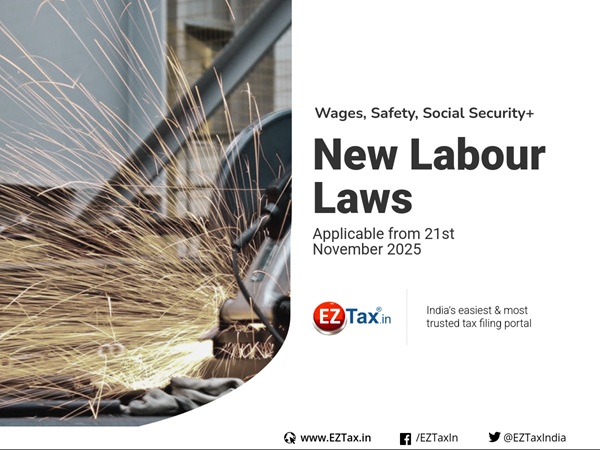3.i. The Code of Wages 2019
The Code of Wages 2019 aims to simplify, consolidate and rationalize the provisions of existing 4 acts.
It aims to strengthen the workers’ rights and promote simplicity and uniformity in wage related compliance for employers.
Major highlights of this code are as follows
- Universal Minimum wages for all employees in both organized and unorganized sectors. Earlier it used to apply for only scheduled employments covering 30% of workers.
- Floor Wages will be set up by Government based on certain criteria like minimum living standards, regional variation etc
- Gender Equality in Employment and there should be no discrimination
- Wage Fixation will be determined by Government based on various criteria like skill levels, geographic area, job conditions etc
- Provisions for ensuring timely payment and preventing unauthorized deductions will apply to all employees irrespective of wages. Earlier it is applicable for wages upto Rs 24,000 per month.
- Overtime Compensation should be paid to all employees at least twice the normal rate for any work done beyond the regular working hours
- Employers should take responsibility for any unpaid wages
- First time non imprisonable offences can be compounded by paying a penalty. However, repeat offences within 5 years cannot be compounded.
3.ii. The Industrial Relations Code 2020
The Industrial relations code 2020 consolidates the 3 acts and aims to simplify laws related to trade unions, conditions of employment in industrial establishment or undertaking, investigation and settlement of industrial disputes.
Major highlights of this code are as follows
- Fixed term employees should receive all benefits equal to permanent workers including wages, leaves, medical and social security
- Fixed-term employees become eligible for gratuity after only one year of service, a reduction from the previous requirement of five years.
- The worker definition is expanded and now it includes sales promotion staff, journalists, and supervisory employees earning up to ₹18,000/month
- The Industry definition is expanded and now it includes all systematic employer- employee activities, regardless of profit or capital, widening access to labour protections.
- Work from Home Provision is permitted in service sectors by mutual consent
- Trade Unions with 51% membership get recognition as negotiating union
3.iii. The Code on Social Security 2020
The code on social security consolidates 9 social Security acts and it extends the social security to all workers including unorganized, Gig, Platform workers covering life, health, maternity and provident fund benefits
Major highlights of this code are as follows
- ESIC now applies to PAN India instead of notified areas. Establishments with less than 10 employees can opt on voluntary basis with mutual consent of employers and employees.
- Gig and Platform Workers are also eligible for social security benefits and the aggregator should contribute 1-2% of annual turnover capped at 5% of payments to such workers. Eg: food delivery companies
- Employers employing more than 20 workers to mandatorily report vacancies online
- "Wages" now include basic pay, dearness allowance, and retaining allowance; 50% of the total remuneration (or such percentage as may be notified) shall be added back to compute wages, ensuring consistency in calculating gratuity, pension, and social security benefits.
- Accidents during travel between home and workplace are now deemed employment- related and it qualifies for compensation
- The definition of dependents is expanded and coverage extends to maternal grandparents and in case of female employees it also includes dependent parents-in- law, broadening family benefit access.
- Aadhaar based Universal Account Number (UAN) will be introduced to ensure seamless portability
3.iv. The Occupational Safety, Health and Working Conditions Code 2020
The code consolidates 13 Social Security acts and it aims to safe guard worker rights, safe working conditions and create a business-friendly regulatory environment.
The Major highlights are as follows
- A uniform threshold of 10 employees is set for electronic registration. One registration will create a centralized database and promotes ease of doing business
- The Government can extend the code provisions to any establishment even with 1 employee engaged in hazardous or life-threatening occupations.
- This code introduces 1 licence, 1 registration and 1 return framework which helps in simplified compliance
- Free Annual health checkups should be provided for all employees
- Appointment letters should be given to all employees specifying the job details, wages, social security and it will enhance transparency and accounting.
- Women can work in all types of establishments and during night hours (before 6AM, beyond 7PM) with consent and safety measures.
- Normal working hours peak at 8 hours/day and 48 hours/week. Overtime is allowed only with worker consent and paid at twice the regular rate
- The definition of inter-state migrant workers (ISMW) now covers workers employed directly, through contractors, or migrate on their own. Employers should provide a lump-sum annual travel allowance to native place once in 12 months and portability of public distribution system and social security benefits across states along with access to a toll-free helpline.
- Strengthens women-centric provisions by providing maximum 26 weeks of maternity leave of which upto 8 weeks can be taken before delivery and flexibility of work from home option
NOTE
As on 22nd Nov 2025, the introduction of four labour forms is a historic and great labour reform by the Government of India. It simplifies the old laws and makes compliance easy.
However the Government is yet to notify the process of registration, filing returns, challan payments, Website etc. Once these are clear and live, the employees and employers will have clarity on the same
 4.8 ★★★★★ Excellence since 2016
4.8 ★★★★★ Excellence since 2016 